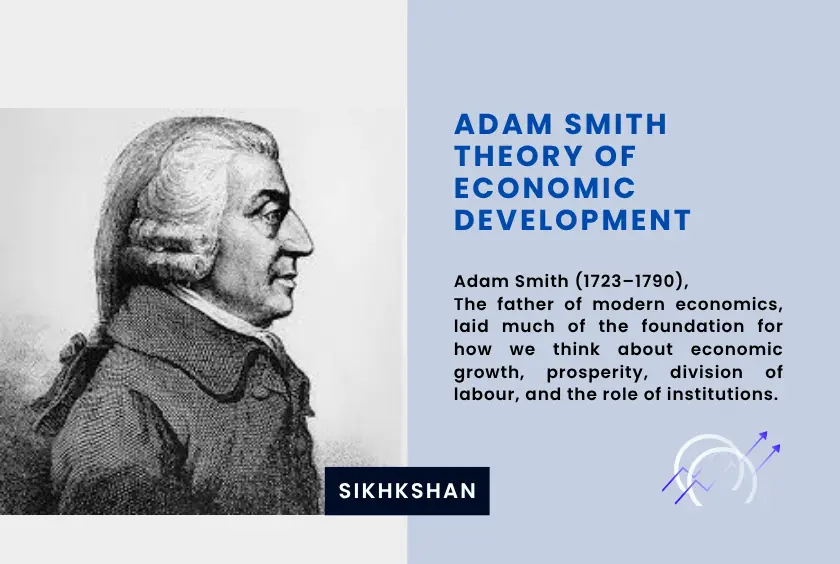Adam Smith’s Theory of Economic Development
Adam Smith (1723–1790), often called the father of modern economics, laid much of the foundation for how we think about economic growth, prosperity, division of labour, and the role of institutions. His most important work in this regard is An Inquiry into the Nature and Causes of the Wealth of Nations (1776). What follows is a comprehensive examination of his theory of economic development: what it is, how it works, what limits it, and how relevant it remains.
1. Key Concepts: What Drives Economic Development for Smith
Smith’s model of development has several interlocking parts. Some of the most important are:
- Division of Labour
- Smith famously begins Wealth of Nations with the example of a pin factory: by dividing tasks among workers, output can increase massively compared to what any individual could do alone. (Encyclopedia Britannica)
- Division of labour increases productivity in three main ways: enhances dexterity, saves time (less switching between tasks), encourages invention of machines/tools to simplify operations. (Adam Smith Works)
- Accumulation of Capital (or Stock)
- Before division of labour can fully expand, there must be sufficient capital: tools, machinery, inventory, and remuneration. Without that “stock,” the more refined divisions of labour aren’t possible because you need to support more workers and more specialized equipment. (Encyclopedia Britannica)
- Saving is crucial: individuals’ savings lead to investment, which increases the stock of capital. (Taylor & Francis Online)
- Extent of the Market
- Smith emphasizes that division of labour is limited by the size of the market. If there are not enough buyers, or the market is too small geographically or in purchasing power, then high specialization is not profitable or sustainable. (Taylor & Francis Online)
- As markets expand (through trade, better transport, etc.), specialization increases, productivity rises. (Adam Smith Works)
- Technical Progress and Innovation
- While Smith did not present a formal theory of technological growth as in modern endogenous growth theory, he saw invention, machines, tools, and improved methods (often arising out of division of labour) as sources of productivity growth. (Adam Smith Works)
- These technological improvements tend to reduce the cost (in labour‐terms) of wage goods, raising real wages for labourers. (Taylor & Francis Online)
- Population, Wages, and Profits Interaction
- Smith thought that rising wages would tend to attract more labourers (by improving survival, reducing child mortality, etc.), increasing supply of labour, thereby moderating wages. (Encyclopedia Britannica)
- Profits and wages are connected: accumulation increases capital → increases demand for labour → wages go up → profits tend to fall (since cost of labour is rising relative to output). This dynamic tension between profits, wages, and accumulation is central. (Encyclopedia Britannica)
- Role of Institutions and Policy / Restrictions
- Smith sees institutional arrangements, property rights, freedom to trade, competition, and minimal but effective government intervention as essential. He was critical of mercantilist policies, monopolies, privilege granted to certain merchants or manufacturers. (Encyclopedia Britannica)
- Natural progress of opulence: in Book III of Wealth of Nations, he discusses how nations advance — agriculture first (because basic subsistence), then manufacturing, trade, etc. (Adam Smith Works)

2. The Process: How Smith Envisions Development Unfolding
Putting the pieces together, here’s how Smith’s model of economic development more or less works, step by step.
| Stage | Description |
|---|---|
| Initial conditions | A society with some capital, labour, land — but not yet fully specialized, perhaps with low productivity, limited market exchange. |
| Capital accumulation & saving | Individuals save, invest, expand stock: tools, infrastructure, provisions. This supports more employment, more capacity. |
| Division of labour | With more capital, labour can specialize. Specialization yields productivity gains. Machines/tools improve. |
| Expansion of market | As output increases, exchange (both local and international) increases, markets enlarge. More specialisation becomes profitable. |
| Technical improvement | Innovations in tools, machinery, methods reduce costs, increase output, improve real wages. |
| Population & wages adjustment | Wages rising attract more labour (population growth / better survival), eventually moderating wage rises; profits may decline but competition and accumulation keep growth going. |
| Institutional environment & removal of impediments | Removal of monopolies, restrictions, protections that distort trade; proper property rights, competitive markets; patterns of agriculture→manufacturing→trade. |
3. Limits, Dilemmas, and Critiques within Smith’s Theory
Smith is not blindly optimistic; he acknowledges constraints and has a nuanced view of potential pitfalls. Some of the limits and contradictions are:
- Limits of market size/extent of market: As noted, specialization depends on large enough markets. Small or closed economies may get stuck in less specialized, less productive states. (Taylor & Francis Online)
- Diminishing profits: As capital accumulates, competition and rising wages can squeeze profit margins. If profits fall too much, there is less incentive to accumulate, which could slow growth. (Encyclopedia Britannica)
- Natural wage vs. actual wage: Smith distinguishes between what wages “should be” in a free and advancing economy (natural wages) and what they are in practice (could be lower due to bargaining power, institutions, monopsony, etc.). (Taylor & Francis Online)
- Distributional issues: While Smith wants “universal opulence” — wealth spreading to the poorest — in practice, there are inequalities: those who own capital, land will often benefit more, especially early in development. Behaviour of landlords, capitalists, merchants may distort outcomes. (Encyclopedia Britannica)
- Non‐labor‐saving limits: Smith doesn’t always assume that machinery reduces labour (labour‐saving); in some cases, new tools require more labour or just shift where labour is demanded. Also, some sectors may not show big productivity gains.
- Role of externalities, public goods, infrastructure: Smith didn’t have a fully developed theory of externalities, or how public infrastructure, education, health etc. factor in. Modern critics say these are necessary for sustained growth. Smith does discuss some state role (defence, justice, infrastructure).
4. Natural Progress of Opulence & Historical Order
In Wealth of Nations, particularly Book III, Smith outlines what he calls the “natural progress of opulence”:
- He argues historically most countries followed a pattern: agriculture → manufacturing → trade. Agriculture is the foundation (subsistence, food), then as surplus builds, manufacturing grows, trade expands. (Adam Smith Works)
- However, historical contingencies often cause deviations: invasions, political systems, privileges or restrictions can invert or distort this order. For example, sometimes manufacturing/distribution/trade develop faster than agriculture, etc. Smith analyses these variations. (Adam Smith Works)
5. What Smith Wanted: Universal Opulence
A key normative aim in Smith’s theory is what he calls “universal opulence”. By this he means a standard of wealth and output that is spread widely enough to reach the lowest ranks of society. (Taylor & Francis Online)
- He sees raising wages and improving conditions for labourers as not just by‐products but necessary outcomes of growth.
- Real wages depend on two things: the price of wage goods (which technology, productivity, division of labour help lower), and the nominal wages (which are influenced by capital accumulation, bargaining, etc.). Higher productivity → cheaper wage goods → even moderate nominal wages yield good real income. (Taylor & Francis Online)
6. Relevance to Modern Growth Theories
Many elements of modern economic growth theory echo Smith. Some points:
- Endogenous growth theory: The idea that growth arises from factors inside the economy: human capital, innovation, productivity improvements. Smith’s view of technical progress via division of labour, accumulation is (in spirit) similar.
- Role of institutions: Modern economic literature increasingly recognizes the importance of strong institutions, free and fair markets, property rights – all ideas Smith emphasized.
- Trade, openness, market expansion: Globalization and trade connect to Smith’s “extent of market” idea: larger markets allow specialization and learning, improves productivity.
- Distributional consequences: The tension between profits, wages, and capital accumulation as Smith saw — still central in discussions of inequality, wage stagnation, profit share, etc.
7. Examples & Case Studies
To illustrate, here are some examples (both historical and modern) that reflect Smith’s theory in action or its limitations.
- Industrial Revolution (Britain, late 18th / early 19th century)
Britain had a growing domestic market, accumulation of capital, developments in agriculture, transport (canals, roads), inventions (steam engine, textile machinery) — all played together as Smith would expect. - East Asian Tigers (South Korea, Taiwan, Singapore)
They show rapid accumulation, investment in capital, expansion of markets (both domestic and export), technological importation and adaptation, plus institutional reforms. - Small economies vs. large economies
Some small, isolated economies struggle to achieve high division of labour because their markets are too small; they rely more on trade (importing specialized goods) or suffer lower productivity. - India’s experience (if applying Smith’s framework)
India is huge, so extent of market is not a problem domestically. But institutional constraint, capital accumulation, and technical progress have varied across sectors; agriculture modernization, manufacturing growth, and infrastructural improvements illustrate Smithian dynamics but also show where frictions remain.
8. Criticisms & Extensions
Smith’s theory, while powerful, has been critiqued or found incomplete in some respects; later economists have built on or modified it.
- Neglect of human capital & education: Smith mentions “dexterity” and learning by doing, but doesn’t fully develop the role of formal education, health, etc., which modern economists see as critical.
- Externalities and market failures: Issues like environmental damage, public goods, external costs, monopoly power – these are less developed in his model.
- Role of technological change: Smith saw technical improvement from machines/tools and invention, but lacked a full theory of R&D, innovation incentives, or knowledge spillovers.
- Dynamic diminishing returns and limits: In more modern settings, there might be diminishing returns to capital, resource constraints, or ecological limits which Smith couldn’t foresee fully.
9. Summary: Strengths & Weaknesses
| Strengths | Weaknesses / Gaps |
|---|---|
| Clear, intuitive mechanisms: division of labour, capital accumulation, market size | Under‐specification of human capital, innovation incentives, externalities |
| Emphasis on institutional environment, competition, role of trade | Less attention to state’s role in correcting market failures or providing public goods |
| Moral aim: not just growth for elites but for “lowest ranks” (universal opulence) | Doesn’t fully address inequality dynamics, power relations, or social constraints |
| Insights that remain relevant in modern growth & development economics | Some parts assume conditions (free markets, competitive behaviour) that may not hold in many economies today |
10. Conclusion: Relevance for Today & Lessons
Adam Smith’s theory of economic development remains foundational. For anyone thinking about how countries grow, how economies get richer, how poverty can be reduced, his ideas offer essential guideposts. Here are some lessons and reflections:
- Expanding markets, both domestic and international, is crucial. Trade, infrastructure, connectivity matter.
- Institutions: legal, political, property rights, competition frameworks matter a lot.
- Capital accumulation & savings must be used well — not hoarded, but invested in productive tools, sectors.
- Productivity gains (technology, better tools, better organization) are central to raising living standards.
- Monitoring distribution (wages vs profits) is crucial if growth is to raise wellbeing broadly, not just get high GDP.
Smith’s framework doesn’t answer everything in today’s world (e.g. climate crisis, digital economy, unequal innovation diffusion), but it gives a strong base. For policymakers, the goal is to create conditions where Smith’s mechanisms work: allow freedom and competition, reduce distortions, invest in infrastructure & human potential, and ensure that growth reaches everyone.


